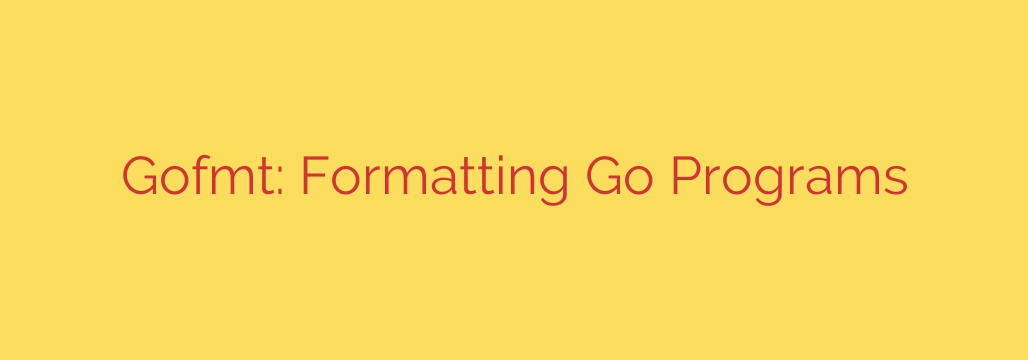
Unlock Code Consistency and Readability with Gofmt
In the world of software development, debates over code style can consume countless hours. Arguments about brace placement, indentation, and line length are common distractions that pull focus from what truly matters: building robust, functional software. The Go programming language offers a powerful and decisive solution to this problem: gofmt.
Gofmt is a command-line tool, included with the standard Go distribution, that automatically formats Go source code according to a single, official style guide. By providing a canonical format, it eliminates style debates entirely, allowing development teams to focus on logic and collaboration.
The Core Benefits of Using Gofmt
Adopting gofmt is not just about making code look pretty; it’s about fundamentally improving the development process. The benefits are immediate and far-reaching, making it an indispensable tool for any Go developer.
- Eliminates Style Debates: With
gofmt, there is only one correct way to format Go code. This puts an end to subjective arguments and ensures that the entire codebase, regardless of who wrote it, adheres to the same standard. - Enhances Code Readability: When all code follows a consistent structure, it becomes significantly easier to read and understand. You can jump into any Go project and immediately feel comfortable with the layout, reducing the cognitive load required to parse the code.
- Simplifies Tooling and Automation: A standardized code format makes it much easier to write automated tools for code analysis, refactoring, and generation. Because the tool doesn’t have to account for endless stylistic variations, it can operate more reliably.
- Focuses on What Matters: By automating the formatting process, developers are freed to concentrate on the program’s logic and behavior. The tool handles the aesthetics, while the engineer handles the architecture.
How Gofmt Achieves Perfect Formatting
The brilliance of gofmt lies in its implementation. It doesn’t use simple text manipulation or regular expressions to reformat code. Instead, it follows a more robust process:
- The tool first parses the source code into an Abstract Syntax Tree (AST), which is a structural representation of the code.
- It then prints this AST back into text, applying a standardized set of rules for indentation, spacing, and line breaks.
This approach ensures that the formatting is always correct and consistent. Any two pieces of code that are functionally identical will produce the exact same output after being processed by gofmt, regardless of their original formatting.
Putting Gofmt into Practice: Essential Commands
Using gofmt is straightforward. The most common way to use it is with the -w flag, which writes the formatted code directly back to the source file.
To format a single file:
gofmt -w main.go
To format all Go files in the current directory and its subdirectories:
gofmt -w .
Other useful flags include:
- -l (list): This flag doesn’t change any files. Instead, it prints the names of the files that would be reformatted. This is extremely useful in CI/CD pipelines to check for unformatted code.
bash
# If any files are unformatted, their names will be printed
gofmt -l .
- -d (diff): This flag displays the differences between the original and formatted code without modifying the file. It’s a great way to preview changes before applying them.
bash
gofmt -d main.go
Integrating Gofmt into Your Daily Workflow
To get the most out of gofmt, it should be an automatic part of your development process. Manually running the command is good, but automation is better.
Editor Integration: Most modern code editors and IDEs, such as VS Code and GoLand, have excellent Go support. You can configure your editor to automatically run
gofmtevery time you save a file. This ensures your code is always perfectly formatted without you ever having to think about it.Pre-Commit Hooks: You can set up a Git pre-commit hook that runs
gofmt -lon your staged files. If any files need formatting, the hook can block the commit, forcing you to format the code before it enters the version control history.Continuous Integration (CI): Your CI pipeline should include a step that runs
gofmt -l .across the project. If the command prints any filenames, the build should fail. This acts as a final backstop to guarantee that no unformatted code is ever merged into the main branch.
Beyond Gofmt: Meet Goimports
For an even more powerful workflow, consider using goimports. This tool is a superset of gofmt. It does everything gofmt does, but it also automatically adds missing import statements and removes unused ones. Most of the Go community considers goimports the de facto standard, and it is the default formatter in many editor extensions.
By embracing tools like gofmt and goimports, you adopt a core philosophy of the Go ecosystem: favor clear, simple, and automated solutions to common problems. This focus on consistency and pragmatism is a key reason why Go is such a productive language for building modern software.
Source: https://www.linuxlinks.com/gofmt-formats-go-programs/







